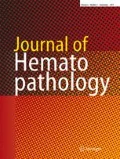Abstract
Classic Hodgkin lymphoma (HL) involving the endometrium is extremely rare as lymphoma involving the female genital tract is uncommon in general and those that do are most commonly non-Hodgkin lymphomas. Here, we present a patient with refractory classic HL where PET scan imaging results led to an endometrial biopsy that confirmed uterine involvement of her disease.
Similar content being viewed by others
A 56-year-old female, who had been diagnosed with classic Hodgkin lymphoma (HL) in a right inguinal lymph node biopsy approximately 2 years earlier, did not respond effectively to conventional treatment. She began a study medication with the intent to proceed to stem cell transplantation. An endometrial biopsy was performed to evaluate for possible uterine involvement by HL based on PET scan imaging results.
Histologic sections of the biopsy revealed fragments of endometrium with a prominent mixed inflammatory cell infiltrate among which were scattered abnormal large lymphoid cells consistent with Reed-Sternberg (RS) cells (Fig. 1a). These cells were immunohistochemically positive for CD30 (Fig. 1b) and PAX5 (Fig. 1c, arrows) and negative for CD45 (Fig. 1d, arrows). The stains for CD3, CD15, CD20, cytomegalovirus (CMV), Herpes simplex virus I + II (HSV), keratin AE1/AE3, and Varicella zoster virus (VZV) were negative in the RS cells, as well (not shown). Additionally, the RS cells were Epstein-Barr virus negative by in situ hybridization for EBV-encoded RNA (EBER). Therefore, it was concluded that this represented endometrial involvement by her classic HL.
Endometrial involvement by classic HL is exceptionally rare and appears to occur as part of widespread disease rather than as the primary site of the tumor [1].
Reference
Ainsworth A, Wood A, Kurtin P, Burnett T (2016) An unusual case of abnormal uterine bleeding due to classical Hodgkin lymphoma identified by endometrial biopsy. Int J Gynaecol Obstet 135(3):331
Author information
Authors and Affiliations
Corresponding author
Ethics declarations
Conflict of interest
The authors declare that they have no conflict of interest.
Rights and permissions
About this article
Cite this article
Terra, S.B.S.P., Wood, A.J. Classic Hodgkin lymphoma involving the endometrium: an extremely rare finding associated with refractory/widespread disease. J Hematopathol 11, 63–64 (2018). https://doi.org/10.1007/s12308-018-0325-3
Received:
Accepted:
Published:
Issue Date:
DOI: https://doi.org/10.1007/s12308-018-0325-3





